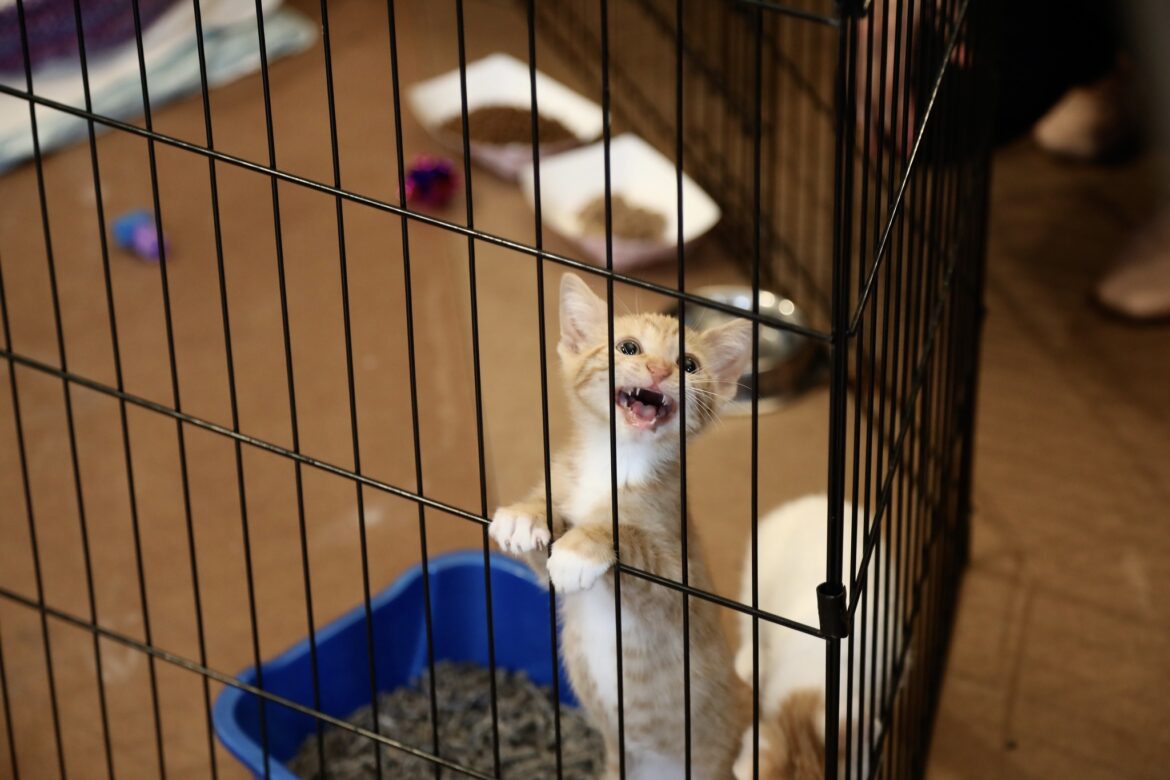“Simply put, we cannot adopt our way out of this crisis. It requires the facilitation of affordable, accessible veterinary care, and it demands that New York City officials assume their share of responsibility for overpopulation control as mandated by city code.”
Violet Mendelsund/Mayoral Photo Office
A cat adoption event at City Hall in 2022.
CityViews are readers’ opinions, not those of City Limits. Add your voice today!
Economic instability—compounded by lack of affordable, pet-friendly housing—enabled a pet abandonment epidemic during and after the COVID-19 pandemic, and most of those animals were not spayed or neutered.
Nearly four years later, the animal rescue community continues to barely tread water, especially donor-dependent, volunteer-led rescue spaces like Puppy Kitty New York City Inc. (PKNYC).
New York City needs city-funded, high-volume spay-neuter programs that provide free or low-cost spay-neuter services to every New Yorker. As PKNYC president, I can attest to the need for city dollars to alleviate shelter populations, especially if those funds support high-volume, low-cost or free spay/neuter services and operation of more affordable vet clinics to address this dire situation.
NYC Local Law 59 states simply: “Every owner of a cat who permits such cat to roam outside the interior of the owner’s dwelling shall have such cat sterilized. At the request of employees or authorized agents of the department, owners shall provide proof satisfactory to the department that a cat found roaming has been sterilized.”
Our current system, however, provides no affordable means for residents to comply with this mandate, placing the heaviest burden on citizen volunteers. In fact, New York City Council Member Justin Brannan, chair of the council’s finance committee and an ardent animal-lover, confirmed recently to Brooklyn Paper that the city currently spends less than 5 percent of its animal welfare budget on what it categorizes as “upstream” actions such as spay/neuter services.
What does that mean for the current cat overpopulation crisis?
The city Health Department’s six-year, $3 million budget for low-cost spay/neuter surgeries enables roughly 24,000 annual procedures provided through the ASPCA, or fewer than one-third of the 85,000 spay/neuter surgeries low-income households require each year outside of local strays and “community” cats.
Simply put, we cannot adopt our way out of this crisis. It requires the facilitation of affordable, accessible veterinary care, and it demands that New York City officials assume their share of responsibility for overpopulation control as mandated by city code.
Alexandra Silver, who serves currently as director of the Mayor’s Office of Animal Welfare, is that office’s only full-time staffer. Solving a crisis of this magnitude cannot fall squarely on the shoulders of a single mayoral appointee.
At the same time, citizen volunteers who take on the financial hardship, physical demands, mental stress and emotional exhaustion that animal rescue entails should not be leaned on so heavily to address what our own law acknowledges as a municipal problem.
If we’re serious about reducing the clogged pipeline of surrendered and abandoned cats and dogs, our efforts must remain cooperative, but it’s past time for city leaders to accept a more direct role. When we intervened in a hoarding case in January, we rescued 34 cats from a single apartment, most of which were sick and neglected, but we managed to arrange adoptions for most of those rescues.
With stronger city support that Herculean effort could have been minimized through stronger protocols and enforcement measures. New York City leaders need to establish and maintain funds for addressing both emergency response and long-term fixes for a cat overpopulation crisis that their lack of local statute enforcement helped create.
New York City’s animal rescue community is diverse, passionate and opinionated, but we are also exhausted. We need our city’s leadership to adopt clearer, more enforceable protocols for addressing the overpopulation crisis and to absorb its share of this municipal burden.
Meagan Licari is president of Puppy Kitty New York City Inc., a nonprofit, volunteer-based animal rescue in Queens serving all of New York City.
The post Opinion: NYC’s Animal Rescue Community is Exhausted appeared first on City Limits.

